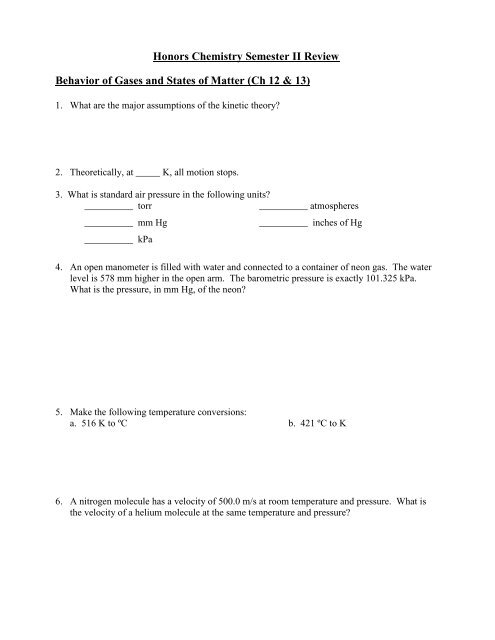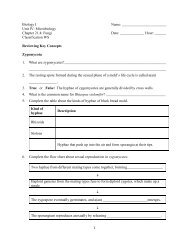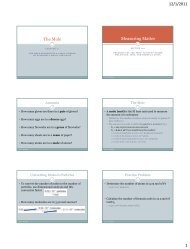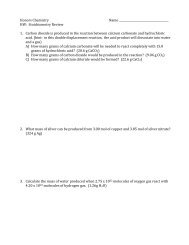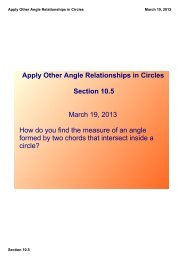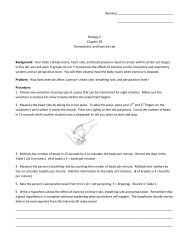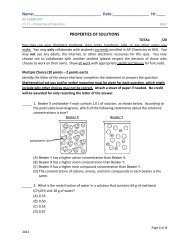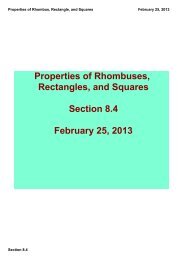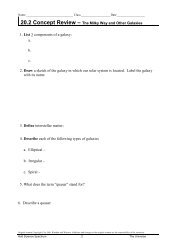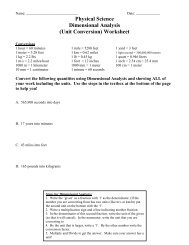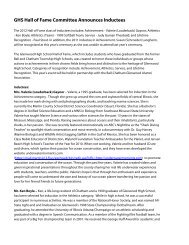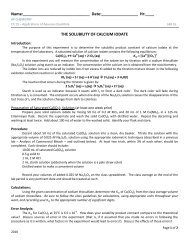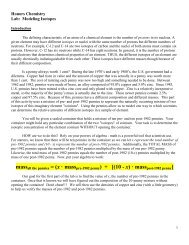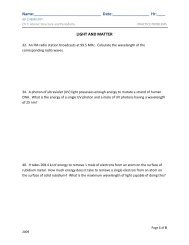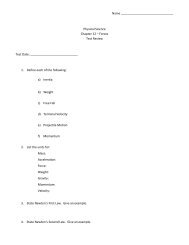Spring Semester Review - Honors Chemistry
Spring Semester Review - Honors Chemistry
Spring Semester Review - Honors Chemistry
You also want an ePaper? Increase the reach of your titles
YUMPU automatically turns print PDFs into web optimized ePapers that Google loves.
<strong>Honors</strong> <strong>Chemistry</strong> <strong>Semester</strong> II <strong>Review</strong><br />
Behavior of Gases and States of Matter (Ch 12 & 13)<br />
1. What are the major assumptions of the kinetic theory?<br />
2. Theoretically, at _____ K, all motion stops.<br />
3. What is standard air pressure in the following units?<br />
__________ torr<br />
__________ atmospheres<br />
__________ mm Hg<br />
__________ kPa<br />
__________ inches of Hg<br />
4. An open manometer is filled with water and connected to a container of neon gas. The water<br />
level is 578 mm higher in the open arm. The barometric pressure is exactly 101.325 kPa.<br />
What is the pressure, in mm Hg, of the neon?<br />
5. Make the following temperature conversions:<br />
a. 516 K to ºC b. 421 ºC to K<br />
6. A nitrogen molecule has a velocity of 500.0 m/s at room temperature and pressure. What is<br />
the velocity of a helium molecule at the same temperature and pressure?
*** Match the law with the description:<br />
a. Boyle’s Law d. Combined Law<br />
b. Charles' Law e. Graham’s Law<br />
c. Dalton’s Law f. Gay-Lussac<br />
_____ 7. The effect of temperature and pressure on volume.<br />
_____ 8. The velocity of a gas is inversely related to the square root of its mass.<br />
_____ 9. The effect of pressure on volume.<br />
_____ 10. P T = P 1 + P 2 + P 3 …<br />
_____ 11. The effect of temperature on volume.<br />
_____ 12. The effect of temperature on pressure.<br />
13. Correct the following gas volumes from the initial conditions listed to the new conditions.<br />
Assume that the pressure or temperature is constant if not given.<br />
a. 95.0 mL at STP to 24.0C and 91.5 kPa b. 245 mL at 5.0C and 92.0 kPa to<br />
40.0C and 785 mm Hg<br />
14. From the volume, temperature and pressure data given, calculate the number of moles and the<br />
mass in grams for each gas listed:<br />
a. 2000.0 mL NH 3 at 10.0ºC and 105.0 kPa b. 5.00 dm 3 SO 2 at 21.0ºC and 100.0 kPa<br />
15. Calculate the volume each gas will occupy under the conditions listed.<br />
a. 5.00 mol CH 4 at 27.0ºC and 97.2 kPa b. 200.0 g NH 3 at 12.0º C and 777 mm Hg<br />
2
16. What happens to pressure if:<br />
a. the volume decreases to ¼ V?<br />
b. the temperature increases to 1.5 T?<br />
c. the number of moles increases to 3 times the moles?<br />
17. How many mL of hydrogen gas can be produced when 6.05 g HCl reacts with 5.15 g of Mg<br />
at STP?<br />
18. Calculate the volume that 0.881 mol of gas will occupy at STP.<br />
19. What is the density of CO 2 at STP?<br />
20. Ammonia is synthesized from its elements. If 5.00 L of nitrogen gas reacts with excess<br />
hydrogen gas, what volume of ammonia can be produced at STP?<br />
Miscellaneous Info about Water and Aqueous Systems<br />
1. In a closed, insulated system, ice is floating in water. The temperature is 0.0ºC. Will all of<br />
the water freeze? Why?<br />
2. Water is boiling at 100ºC. The hot plate's surface temperature is increased. Will the water<br />
now boil at a higher temperature?<br />
3. Is the vapor pressure of the liquid phase and the vapor pressure of the gas phase equal at the<br />
boiling point?<br />
3
4. Are the attractive forces between the particles strong or weak when the vapor pressure of a<br />
substance is high?<br />
5. When hydrogen is bonded to a highly electronegative element, what intermolecular attractive<br />
force results?<br />
6. How much energy is required to raise the temperature of 175 g H 2 O from 11.0ºC to 140.0ºC?<br />
7. What happens to the solubility of a solid if the temperature of the solution increases?<br />
8. What happens to the solubility of a gas if the temperature of the solution increases?<br />
9. How is a colloid different from a solution?<br />
Solutions (Ch 14)<br />
1. Calculate the molarity of the following solutions:<br />
a. 500.0 cm 3 that contains 82.0 g b. 250.0 mL that contains 50.0 g<br />
calcium nitrate<br />
copper II sulfate pentahydrate<br />
2. Calculate the mass of solute needed for the following:<br />
a. 255 mL of 2.00 M Na 2 SO 4 7H 2 O b. 1.500 dm 3 of 0.0240 M KH 2 PO 4<br />
3. Calculate the molality of the following solutions:<br />
a. 15.0 g ethanol dissolved in 250.0 g water b. 1.20 x 10 23 molecules acetic acid<br />
dissolved in 1500.0 g water<br />
4
4. Describe how you would make the following solutions:<br />
a. 2.50 m solution of glucose containing 2000.0 g water<br />
b. 1.25 m solution of NaCl containing 26.0 g NaCl<br />
5. Determine the mass of ethylene glycol C 2 H 4 (OH) 2 , which must be dissolved in 2500.0 g water<br />
to make a 4.00 m solution.<br />
6. Calculate the mole fraction of methanol, CH 3 OH, when 3.20 g of methanol is dissolved in 4.61<br />
g of ethanol, CH 3 CH 2 OH.<br />
7. What is a colligative property?<br />
8. What are the freezing and boiling points of a solution that contains 10.0 g naphthalene, C 10 H 8 ,<br />
dissolved in 50.0 g water?<br />
9. How many grams of an organic compound (molecular mass 75.0g/mol) must be dissolved in<br />
500.0 g water to lower the freezing point of the solution to –2.57 ˚C?<br />
10. What is the molecular mass of an organic compound if 16.0 g of the compound, when<br />
dissolved in 225.0 g water, increased the boiling point by 8.56 C?<br />
5
11. Which substance forms the better electrolyte and WHY? 3 M NaCl or 4 M sucrose?<br />
12. How would you make a supersaturated solution?<br />
13. If the solubility of a gas in water is 5.25 g/100 mL when the pressure above the gas is 105.7<br />
kPa, what is the solubility when the pressure is 101.3 kPa?<br />
14. If the % (M/V) concentration for the solute is 5.0 % and the volume of the solution is 500.0<br />
mL, what is the mass of the solute?<br />
Acids and Bases (Ch 18)<br />
1. Define an acid according to the following theories:<br />
a. Arrhenius<br />
b. Bronsted-Lowry<br />
c. Lewis<br />
2. What are the products of a neutralization reaction? What is the difference between a strong<br />
and a weak acid?<br />
3. Name the following acids and bases:<br />
a. H 2 S d. H 3 PO 4 g. H 2 SO 3<br />
b. H 2 SO 4 e. HClO 3 h. HI<br />
c. Mg(OH) 2 f. Al(OH) 3 i. KOH<br />
6
4. Label the acid, base, conjugate acid, and conjugate base in the following reactions:<br />
a. HSO 4<br />
- (aq) + Cl - (aq) SO 4<br />
2- (aq) + HCl (aq)<br />
b. OH - (aq) + CH 3 COOH (aq) CH 3 COO - (aq) + H 2 O (l)<br />
5. The approximate pH of some common substances is listed below. Calculate the pOH, [H 3 O+],<br />
and the [OH-].<br />
a. vinegar, 2.90 b. soft drink, 3.00 c. egg, 7.80<br />
6. How many cm 3 of 0.500 M NaOH are required to completely neutralize 20.00 cm 3 of each of<br />
the following acids:<br />
a. 0.150 M HNO 3 b 0.450 M H 3 PO 4<br />
7. How many moles of aluminum hydroxide are required to neutralize 3 moles of phosphoric<br />
acid?<br />
7
Organic <strong>Chemistry</strong> (Ch 21 & 22)<br />
1. A chain compound in which all carbon-carbon bonds are single is called a(n) _____________<br />
or a ________________________.<br />
2. The boiling point of the alkanes (increases or decreases) with more branches.<br />
3. With increasing molecular mass of compounds within a homologous series, the boiling point<br />
______________________. The smallest alkanes are _________________ at room temperature.<br />
4. Name the following compounds:<br />
a. C 5 H 12 b. C 8 H 18 c.C 8 H 16 d. C 4 H 6<br />
5. Draw structural formulas for the following:<br />
a. Benzene b. cyclohexane c. 4-ethyl-2,3-dimethyloctane<br />
d. 2-butene e. 1-hexyne f. Heptanoic acid<br />
6. Name the following molecules:<br />
a. b.<br />
c. d.<br />
7. ____________________ are substances with the same formula but different arrangements.<br />
8. Draw three structural isomers of C 6 H 14 :<br />
8
9. Draw and label structures that are examples of each of the following types of isomers: cis,<br />
trans, positional, functional, and optical isomers.<br />
10. Draw structural formulas and predict the products of the following:<br />
a. 2-butene + hydrogen iodide <br />
b. bromine + ethene <br />
c. complete combustion of ethane<br />
d. elimination of water from 1-pentanol<br />
e. benzene + chlorine gas <br />
f. ethanoic acid + ethanol <br />
9
Nuclear <strong>Chemistry</strong> (Ch 24)<br />
1. Sodium-24 has a half-life of 15.0 hours. How much sodium-24 will remain from a 18.0 g<br />
sample after 33.5 hours?<br />
2. What happens when a neutron beaks down?<br />
3. Write nuclear equations for these reactions:<br />
a. the alpha decay of Po-218:<br />
b. the beta decay of Pb-210:<br />
c. the electron capture by Be-7:<br />
d. the positron emission of F-19:<br />
4. Complete the following transmutation reactions:<br />
a. Li-6 reacts with a neutron to form an alpha particle plus one other particle. What is<br />
the missing particle?<br />
b. U-235 is bombarded with a neutron to form Rb-90 and Cs-144. What are the missing<br />
particles?<br />
10
5. An artifact is found to contain 0.73 times the C-14 found in a living plant. What is the<br />
approximate age of the plant?<br />
6. Calculate the binding energy of an N-14 atom (mass = 14.00307 amu):<br />
Thermochemistry (Ch 15)<br />
1. What is the amount of heat required to raise the temperature of 200.0 g of aluminum by<br />
10ºC?<br />
2. What is the specific heat of a substance a 2.78 g sample of the material absorbs 241 J of<br />
energy when its temperature increases by 175ºC.<br />
3. A student mixed 100.0 mL of water at 47.2ºC with 35.0 g lead at 112ºC. What was the<br />
final temperature of the mixture?<br />
11
4. Use Hess’s Law and the following thermochemical equations to produce the<br />
thermochemical equation for the following reaction:<br />
C (s, diamond) C(s, graphite)<br />
What is the H for the reaction?<br />
C (s, graphite) + O 2 (g) CO 2 (g)<br />
C (s, diamond) + O 2 (g) CO 2 (g)<br />
H = -394 kJ<br />
H = -396 kJ<br />
5. Calculate G system for each process and state whether the process is spontaneous or<br />
nonspontaneous:<br />
a) H system = 145 kJ, T = 293 K, S system = 195 J/K<br />
b) H system = -232 kJ, T = 273 K, S system = 138 J/K<br />
12


